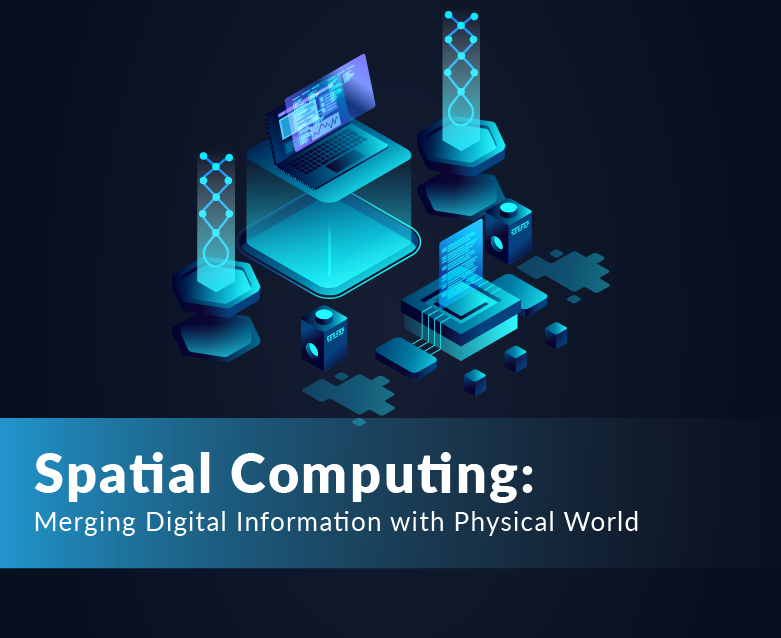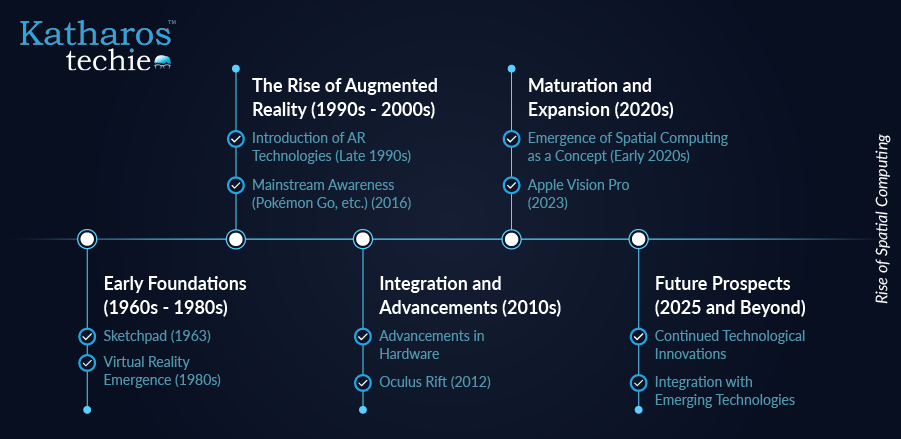
Spatial Computing: Merging Digital Information with Physical World
By Ankita Das

Spatial computing represents a transformative approach integrating digital information with the physical world, enhancing user interactions. This technology encompasses augmented reality (AR), virtual reality (VR), and mixed reality (MR), creating immersive experiences across various sectors. The global spatial computing market is projected to reach $620.2 billion by 2032, reflecting its growing significance. As industries increasingly adopt spatial computing, understanding its core principles and applications becomes essential. This blog discusses the technology’s origins, current state, and future potential, highlighting its impact on society and various industries.
What is Spatial Computing?

Spatial computing is using technology to merge digital information with the physical environment. It enables seamless interaction between users and their surroundings. The origins of spatial computing can be traced back to the early developments in augmented reality (AR) and virtual reality (VR) technologies. In the 1960s, Ivan Sutherland created the first head-mounted display system, the “Sword of Damocles.” This pioneering device laid the groundwork for future innovations in immersive technologies, even though it was basic by today’s standards.
As technology progressed into the late 20th century, AR and VR began to take shape more distinctly. This technology emerged to blend digital information with the physical environment. In 2003, Simon Greenwold further defined spatial computing in his thesis at MIT Media Lab, emphasizing its role in integrating digital content into real-world contexts. This definition highlighted the potential for spatial computing to transform how we perceive and interact with our surroundings.
Today, with the integration of advanced technologies, spatial computing has become a critical component of numerous applications. Its growing adoption underscores its potential to enhance user experiences and operational efficiencies. Moreover, as consumer demand for interactive experiences rises, businesses invest in these technologies to stay competitive. This trend indicates a future where technology will play a pivotal role in shaping how we interact with digital content and the physical world.
What is the Need for Spatial Computing Across Industries?
The need for spatial computing arises from the limitations of traditional computing methods in understanding and interacting with complex physical environments. Conventional systems often struggle to provide the immersive, real-time data necessary for effective decision-making in dynamic settings. As industries evolve, the demand for technologies that enhance user experiences and operational efficiencies has become increasingly critical.
Here are some examples of Industries using Spatial Computing:
- Healthcare: Spatial computing significantly improves patient care by offering accurate simulations and visualizations. For example, augmented reality (AR) technologies allow surgical teams to overlay essential information during operations, leading to better outcomes. A study found that AR applications can reduce surgical errors by up to 35%, underscoring the technology’s potential impact.
- Manufacturing: This industry faces challenges in optimizing workflows and minimizing errors. Spatial computing addresses these issues by providing real-time data insights and facilitating collaboration. Companies like Ford have reported substantial reductions in training time and costs through AR applications for vehicle assembly training.
The rise of remote work further necessitates innovative collaboration solutions. Spatial computing enables virtual meetings that simulate physical presence, enhancing communication among distributed teams. As businesses adapt to new work environments, the demand for immersive technologies will only increase.
Benefits of Spatial Computing Across Industries
Spatial computing offers numerous benefits across various industries by integrating digital information with the physical environment. Below is a table summarizing its key benefits, specific use case descriptions, and examples from different sectors.
| Industry | Benefit | Use Case Description | Example |
| Architecture | Enhanced Visualization | Provides immersive 3D visualizations for a better understanding of complex data. | Architects use AR to create interactive building models. |
| Manufacturing | Real-time Training | Facilitates on-the-job training with AR overlays, improving skill acquisition. | Ford uses AR for vehicle assembly training, reducing errors. |
| Corporate | Improved Collaboration | Enables remote teams to collaborate in virtual environments, simulating physical presence. | Companies use VR for virtual meetings that enhance communication. |
| Retail | Enhanced Customer Engagement | Offers interactive experiences that allow customers to visualize products before purchase. | Sephora’s Virtual Artist app lets users try on makeup virtually. |
| Pharmaceuticals | Data Visualization and Analytics | Allows intuitive exploration of complex datasets through AR and VR interfaces. | Data scientists analyze 3D molecular models for drug discovery. |
| Mining | Improved Safety Training | Simulates hazardous environments for training without real-world risks. | Mining companies use VR simulations to train workers safely. |
These benefits illustrate how spatial computing transforms industries by enhancing user experiences and operational efficiencies. As organizations increasingly adopt these technologies, the potential for innovation and improved outcomes will continue to grow.
Market Growth and Future Trends of Spatial Computing

The market for spatial computing is expected to experience significant growth over the next decade due to increasing adoption across various sectors. According to a source, the global market could reach $620.2 billion by 2032, from USD 142.6 billion in 2023, growing at a CAGR of 18.3% between 2024 to 2033.
Advancements in AI, machine learning, and sensor technologies drive this growth by enhancing spatial awareness capabilities. Companies are investing heavily in research and development to leverage these technologies effectively; Microsoft’s HoloLens has gained traction in enterprise applications due to its ability to merge digital content with real-world environments.
Future trends indicate a push towards more immersive experiences that integrate seamlessly into daily life as 5G networks expand globally; they will enable faster data transmission necessary for real time applications of this technology. Additionally, as augmented reality becomes more accessible through mobile devices, consumer engagement will likely increase.
The convergence of virtual and augmented reality will redefine how businesses approach customer interactions and employee training as industries recognize the potential benefits of this technology in driving efficiency and innovation.
Final Thoughts
Spatial computing represents a transformative shift in how we interact with our environment through technology. Its applications span numerous industries while significantly enhancing efficiency and user experience across sectors such as healthcare and retail. Staying informed about advancements is crucial for effectively leveraging its potential. As this field evolves rapidly, engage with us as we explore further developments in technologies.